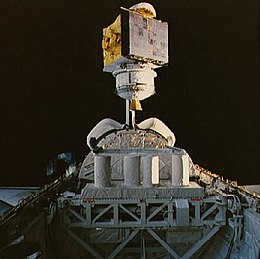 Satcom-K1 is deployed from Columbia's payload bay. | |
| Names | Space Transportation System-24 |
|---|---|
| Mission type | Satellite deployment Microgravity research |
| Operator | NASA |
| COSPAR ID | 1986-003A |
| SATCAT no. | 16481 |
| Mission duration | 6 days, 2 hours, 3 minutes, 51 seconds |
| Distance travelled | 4,069,481 km (2,528,658 mi) |
| Orbits completed | 98 |
| Spacecraft properties | |
| Spacecraft | Space Shuttle Columbia |
| Launch mass | 116,121 kg (256,003 lb) |
| Landing mass | 95,325 kg (210,156 lb) |
| Payload mass | 14,724 kg (32,461 lb) |
| Crew | |
| Crew size | 7 |
| Members | |
| Start of mission | |
| Launch date | January 12, 1986, 11:55:00 UTC (6:55 am EST) |
| Launch site | Kennedy, LC-39A |
| Contractor | Rockwell International |
| End of mission | |
| Landing date | January 18, 1986, 13:58:51 UTC (5:58:51 am PST) |
| Landing site | Edwards, Runway 22 |
| Orbital parameters | |
| Reference system | Geocentric orbit |
| Regime | Low Earth orbit |
| Perigee altitude | 331 km (206 mi) |
| Apogee altitude | 338 km (210 mi) |
| Inclination | 28.45° |
| Period | 91.20 minutes |
| Instruments | |
| |
 STS-61-C mission patch  Standing: Nelson, Hawley and Nelson Seated: Cenker, Bolden, Gibson and Chang-Díaz | |
STS-61-C was the 24th mission of NASA's Space Shuttle program, and the seventh mission of Space Shuttle Columbia. It was the first time that Columbia, the first space-rated Space Shuttle orbiter to be constructed, had flown since STS-9. The mission launched from Florida's Kennedy Space Center on January 12, 1986, and landed six days later on January 18, 1986. STS-61-C's seven-person crew included the first Costa Rican-born astronaut, Franklin Chang-Díaz, the second African-American shuttle pilot, Charles Bolden, and the second sitting politician to fly in space, Rep. Bill Nelson (D-FL). Both Bolden and Nelson would also later go on to become Administrators of NASA. STS-61-C was the last shuttle mission before the Space Shuttle Challenger disaster, which occurred ten days after STS-61-C's landing.